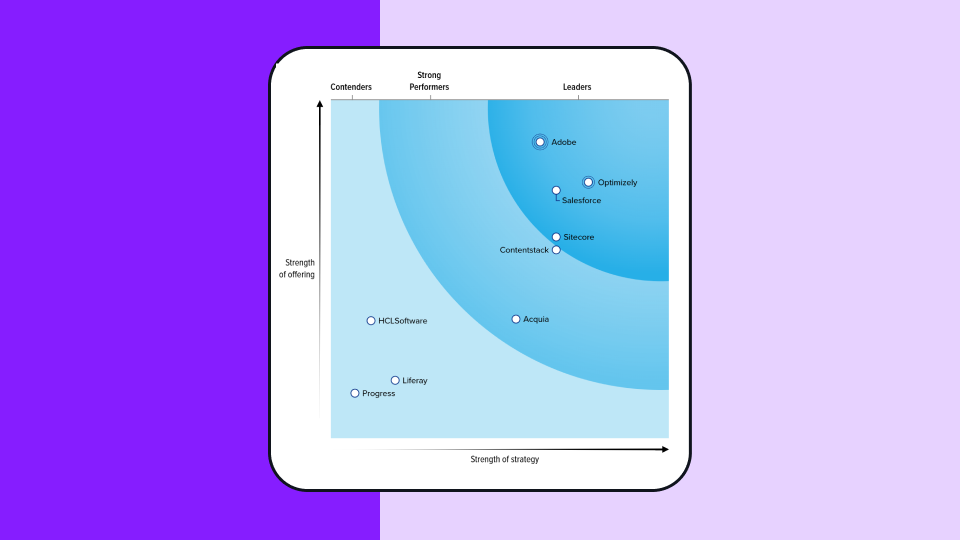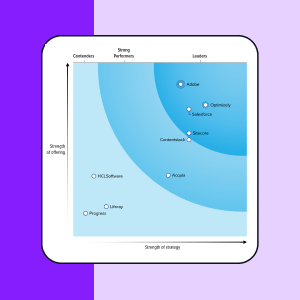The 2025 Optimizely Opal AI Benchmark Report
How marketers are using AI (and what it takes to win with it)
Fair use encouraged. Please attribute to Optimizely.
Introduction
of organizations now use generative AI
According to McKinsey, 78% of organizations now use generative AI in at least one business function. But as adoption (and general AI overwhelm) rises, we’re all asking ourselves three key questions:
- How is everyone else using AI?
- How can AI create value for my organization?
- Are we currently unlocking its full potential?
This report offers insight into how Optimizely Opal is being used across our customer base and what benefits those customers are getting. With three months of usage data from nearly 900 companies, insights from early adopters, and the latest industry research, we explore how AI is actually being used and what benefits adopters are getting from usage.
Find out what’s working, what’s evolving, and what best-in-class AI marketing practices look like today.
Ethan MollickThe New York Times, 2024
About our research
Data sources
Our insights are drawn from three primary data sources:
- Internal Optimizely Opal data: Analyzed usage data across 47,000 Optimizely Opal interactions from customers who adopted Optimizely Opal after its public launch, covering feature adoption patterns, user behavior, and measurable performance outcomes.
- Customer stories from early adopters: Firsthand insights from nearly 900 Optimizely Opal adopters, highlighting their implementation experiences, challenges overcome, and the tangible impacts achieved.
- Industry research: Third-party research and surveys from leading firms like McKinsey and Gartner, providing external context around broader AI adoption trends and transformations in marketing.
Methodology
To ensure statistical rigor and a clean, understandable output, this analysis employed a methodology with a few key components:
Key takeaways
The state of AI
- AI delivers measurable gains, with companies reporting AI-driven improvements from 30% to 91%.
- Optimizely Opal is used across the content lifecycle, led by experimentation (58.7%) and content orchestration (26.6%).
- Adoption spans 50+ countries, led by the US (41.1%), UK (16.2%), and Australia (7.6%).
- Retail (17.4%), Software (11.8%), and Financial Services (9.6%) lead adoption, with growing use in Healthcare (3.2%) and Education (3.6%).
- Companies of all digital maturity levels use Optimizely Opal—high (51.2%), medium (37.1%), and low (11.6%).
- Usage extends beyond specialist teams, reaching senior leaders, marketing, brand, creative, product marketing, customer success, and events.
- The top 1% of users engage with Optimizely Opal nearly 200 times, most often for test ideas, experiment summaries, and AI-generated text and images.
The benefit of AI
- Optimizely Opal Experimentation users achieve more impact, running 78.7% more experiments, launching 24.1% more personalization campaigns, lifting win rates by 9.3% and conclusive rate by 1.4%.
- 10.9% of experiments start with Optimizely Opal-generated ideas, 6.8% are summarized by Optimizely Opal, and 19.5% are follow-ups from Optimizely Opal insights.
- Optimizely Opal users accelerate results, boosting campaign volume 17.1% and task volume by 12.8%. It also cuts campaign completion time by 53.7% and task completion time by 15.4%, while improving content engagement by 7.4%.
- Optimizely Opal-generated content sees high adoption—52.6% of images and 89.5% of text are accepted by users.
- Experiment velocity and content marketing productivity scale linearly with days of usage and credits consumed.
Building a culture of AI
- AI leaders excel by mastering prompt engineering, embedding AI into workflows, optimizing for GEO, and tracking AI success metrics.
- The best programs use clean data, clear brand guardrails, human review, early legal engagement, and team enablement applied within an intentional governance model.
- The future of AI is in multi-agent orchestration ecosystems and generative experience optimization.
The state of AI: Adoption and impact today
Industry transformation at scale
Companies across industries are achieving unprecedented gains by integrating AI into their core workflows.
What is Optimizely Opal?
Today’s marketers are expected to do more than ever—most of the time with fragmented systems, limited (or messy) integrations, and increasing pressure to deliver. At Optimizely, we believe there’s a better, less disconnected, and more integrated way.
Optimizely Opal is more than just another AI assistant or chatbot: it's an extension of your workforce, enabling marketing and digital teams to effortlessly scale the way they work and redefine what’s possible.
From ideation to optimization to analysis—and every step of the marketing lifecycle in between—Optimizely Opal is your agentic, fully-autonomous, and infinitely-scalable AI specialist, helping you complete any marketing and digital job to be done.
Optimizely Opal unlocks infinite scale by working both with you and for you: automating tasks on your behalf, offering proactive insights and suggestions for optimization, creating brand-specific content, and solving your bottlenecks with custom guardrails and control.
Since its launch in May 2025, nearly 900 companies have adopted Optimizely Opal to embed AI throughout their marketing workflows. Top adopters include Diligent, Robinson Club, Elite Hotels of Sweden, and Road Scholar, representing over $2B in annual revenue.
Industry recognition
Industry Analysts are taking notice. Optimizely was named a Leader in the 2025 Gartner® Magic Quadrant™ for Content Marketing Platforms. The report states “Optimizely evolved its stand-alone AI-enabled features into a network of AI agents automating the entire content production and delivery process. It reduced potential AI risks by enhancing its compliance and security features with role-based access control, which is ideal for large enterprises.”
How it’s being used
Experimentation accounts for 58.74% of credit usage, with Content Marketing Platform (CMP) representing 26.58%. The remaining 14.68% is distributed across additional workflows including Optimizely Opal itself, CMS, Data Platform, and Configured Commerce. This distribution shows that approximately 85% of all Optimizely Opal credits are concentrated in just two primary use cases: experimentation workflows and content marketing activities.
Core use cases powered by Optimizely Opal
Optimization
From ideation to analysis, Optimizely Opal optimizes the experimentation lifecycle:
- Experiment Ideation Agent: Provides test ideas for web pages and creative elements.
- Experiment Planning Agent: Generates complete test plans with hypotheses, KPIs, and estimated durations.
- Variation Development Agent: Makes automatic edits to variations based on a prompt.
- Experiment Summary Agent: Summarizes test results and recommends next steps.
- Personalization Ideation Agent: Provides ideas for personalization campaigns.
Content marketing
AI-powered, on-brand content tailored to specific industries, campaigns, and languages:
- Industry Marketer Agent: Creates industry-specific content eliminating the need for comprehensive research, various industry experts, and duplicative work.
- Market Research Agent: Conducts research, compiles insights, and then provides campaign suggestions.
- Keyword Research Agent: Provides suggested keywords based on top business priorities, generates a plan for content clusters, and builds out optimized content in seconds.
- AI Campaign Kits: Generates end-to-end campaigns, including briefs, tasks, supporting content, and social promotion.
- AI Translations: Translates content into multiple languages, instantly.
Brand and workflow customization across products
Optimizely Opal isn't siloed. Instead, it's woven throughout Optimizely One:
- Fully integrated: Embedded in the UI across Optimizely’s product suite.
- Consistent messaging: Brand tone, voice, and content guardrails are set once, then used everywhere.
- Marketing automation: Purpose-built agents to support common marketing and digital use cases.
Digital Agency
Firmographic data: Where is Optimizely Opal being used?
- The US dominates adoption (41.1%), with the UK and Australia close behind. European markets show strong uptake across Germany, Sweden, and the Netherlands.
- Emerging adoption in India and Poland points to global scalability.
- Overall, usage spans 50+ countries, reinforcing that marketing teams around the world are prioritizing smarter, faster ways of working.
Industry uptake: What are the main industries adopting Optimizely Opal?
- Retail leads adoption at 17.4%, driven by the sector's constant demand for fresh, scalable content, hyper-personalized experiences, and rapid campaign execution.
- Software (11.8%) and Financial Services (9.6%) follow closely, while Business Services rounds out the top four at 9.1%.
- Notable adoption across traditionally conservative sectors—Healthcare & Medical (3.2%), Education (3.6%), and Insurance (3.6%)—signals a broader industry shift toward marketing modernization and operational agility.
- The long tail of adoption across diverse industries reflects a growing consensus: AI-powered marketing is transitioning from experimental investment to essential capability across virtually every sector.
Digital maturity: How digitally mature are adopters of Optimizely Opal?
of adopters come from digital-advanced organizations
- The majority of adopters (51.2%) come from digitally-advanced organizations, while more than one-third (37.1%) represent mid-maturity companies leveraging AI to accelerate their digital transformation journey.
- Notably, 11.6% of adoption stems from low digital maturity organizations, demonstrating AI's relatively accessible entry point compared to other advanced technologies.
- The spread suggests that AI is no longer reserved for tech-forward organizations—it’s becoming a lever for transformation at all stages of digital readiness.
What roles are using Optimizely Opal?
Understanding who is using Optimizely Opal—not just which companies, but which roles and teams—provides crucial context for its impact on marketing organizations. Our data reveals an adoption pattern that defies traditional technology rollout models, with usage spreading horizontally across roles rather than remaining confined within specialized teams.
- Senior Leadership/Executives
- Product Marketing Teams
- Customer Success
- Content Marketing
- Digital Marketing
- Field Marketing
- Brand & Creative Teams
- Events Teams
Who is getting the most out of the infinite workforce?
Not all users are equal. Some users are finding significantly more use cases and generating significantly more value than others.
- To be in the top 10% of Optimizely Opal users (power users), you must engage with Optimizely Opal at least 60 times.
- Hitting the top 25% requires just around 30 interactions—a sign of early-stage adoption curve.
- The top 1% use Optimizely Opal 198+ times, often embedding AI into daily workflows.
- At the extreme end, maximum usage reaches 698 interactions, demonstrating how deeply some organizations have integrated AI into their marketing operations.
In a month, these top users typically:
- Send 70+ messages
- Create 45+ tasks
- Create 11+ campaigns
- Create 10+ articles
The most popular Optimizely Opal features for Optimizely's Experimentation are summarizing experiment results and getting test ideas.
The most popular Optimizely Opal features for Optimizely's Content Marketing Platform (CMP) are accessing text generation and generating images.
The benefit of AI: What companies gain from an infinite workforce
To understand Optimizely Opal's true impact, we analyzed performance data from early adopters using a Difference-in-Differences methodology. The results show clear performance improvements that scale with both usage frequency and depth of engagement across optimization and content marketing functions.
Digital optimization
Experimentation programs benefit fundamentally from either more or better experiments. The DiD analysis revealed improvements across both vectors in the headline benchmarks:
+ 78.66% created experiments
+ 2.38% concluded experiments
+ 24.05% created personalization campaigns
+ 11.97% concluded personalization campaigns
+ 9.26% win rate
+ 1.38% conclusive rate
The gap between creation and concluded uplift may stem from the limited reporting window or from early adopters using Optimizely Opal mainly for idea generation, though further analysis suggests that greater engagement leads to more concluded experiments.
Win rate and conclusive rate also rise, signaling modest quality gains. Average uplift dips slightly—a natural effect of higher velocity—but is far outweighed by the surge in volume.
Michael RitchterManager Conversion Optimization & UX | E-Commerce TUI Hotel brands
Analysis of usage and funnel data shows that the best users of experimentation use Optimizely Opal throughout the entire experimentation lifecycle:
- 10.95% of experiments are created from ideas by Optimizely Opal
- 6.80% of experiments are summarized using Optimizely Opal
- 19.54% of experiments are Optimizely Opal-driven follow-ups
Global beauty company
The analysis found that not only was there an uplift in nearly all major experimentation metrics and strong usage throughout the experimentation lifecycle, but also the higher the usage, the greater the uplift.
- The more teams use Optimizely Opal—measured by both active days of usage and credits consumed—the more experiments they create and conclude, scaling linearly with increased engagement.
- The steeper uplift slope for concluded experiments compared to created experiments suggests that increased Optimizely Opal usage is not only driving more experimentation activity, but also improving teams’ ability to bring experiments to a meaningful outcome.
Users can calculate the exact projected uplift of their programs using the equations below, where ‘y’ (the dependent variable) is the expected uplift and ‘x’ (the independent variable) is active days of usage or credit consumed.
Customer story: Unlocking experimentation at scale
This rapid ramp-up showcases how combining robust experimentation infrastructure with AI-driven acceleration unlocks scale and impact that simply wasn’t possible before.
Content orchestration
Similar to experimentation programs, content marketers create more value by either producing more or better revenue-generating content. Companies can also realize value by time or labor savings when marketers become more efficient. The DiD analysis shows benefit across all three of those value drivers:
- + 17.05% campaigns created
- + 12.82% tasks created
- - 53.73% time per campaign
- - 15.41% time per task
- + 7.41% engagement time
The sharp reduction in campaign and task completion times—paired with higher output volumes—shows that Optimizely's Content Marketing Platform (CMP) users are achieving genuine workflow acceleration, not just working faster. At the same time, increased engagement time suggests teams are using Optimizely Opal to produce higher-quality content that holds visitors’ attention and delivers greater value.
Nonprofit education organization
We found these same trends reflected in the funnel data. Content created by Optimizely Opal is getting used by marketers more often than not:
- Optimizely Opal-generated content (both images and text) is being actively adopted by users, not just tested or used for brainstorming.
- Text generation is particularly successful, with almost all generated outputs being used.
- Image generation adoption is strong but with room for further improvement as LLMs ability to create images catches up to their ability to create high-quality text.
B2B technology company
Like with experimentation, the productivity benefits of Optimizely Opal usage in content marketing scale with usage:
- The more teams use Optimizely Opal—measured by both active days of usage and credits consumed—the less time they take to complete tasks and campaigns, with time savings scaling consistently as engagement increases.
- The steeper negative slope for time per campaign compared to time per task suggests that Optimizely Opal usage is driving especially large efficiency gains in campaign delivery, freeing up resources for additional creative and strategic work.
Users can calculate the exact projected uplift of their programs using the equations below, where ‘y’ (the dependent variable) is the expected uplift and ‘x’ (the independent variable) is active days of usage or credit consumed.
Enterprise technology company
Customer story: Accelerating content performance at scale
This surge demonstrates how combining a unified content platform with AI can unlock new levels of scale and efficiency, enabling teams to deliver more high-quality campaigns in less time.
Best practices: How to unlock AI’s full value
The benefits of an integrated AI approach are clear, but not everyone is seeing the same level of success. It’s not quite as simple as switching a new tool on and watching the dollars pour in—it requires a transformation in how teams work.
Here are the best practices that separate AI leaders from everyone else:
-
Master the art of prompt engineering
AI is only as good as the instructions it’s given. The difference between generic output and strategic, on-brand content often comes down to how precisely—and how contextually—you ask.- Be ruthlessly specific: Replace "write a product description" with "create a 150-word description for enterprise buyers emphasizing security features." Specificity eliminates guesswork and delivers exactly what you need.
- Give full context: Share brand voice, campaign data, and target audience details upfront. Use Optimizely Opal's @research command or paste relevant information directly. Rich context transforms generic output into strategic content.
- Iterate like a creative partner: First attempts won't be perfect, so refine with follow-up prompts like "make it punchier" or "add a converting call-to-action." The best results come from treating AI as a collaborator, not a one-shot solution.
-
Embed AI in existing workflows
The biggest barrier to AI adoption isn’t skepticism, it’s friction. If using AI means jumping between tools or breaking focus, it won’t stick. The most effective implementations put AI where the work already happens, making it a seamless part of the process rather than an extra step.- Put AI where work happens: Using AI that's directly embedded into existing solutions and workflows makes it easier for teams to start (and continue) adopting.
- Make AI your strategic advisor: Move beyond content creation to decision-making. Auto-summarize experiment results in plain English and let AI spot data patterns. The real value comes when AI suggests what to optimize next, not just what to write.
- Create frictionless access: The best implementations feel automatic, with AI help appearing exactly when needed. If using AI requires more effort than not using it, your integration needs work.
-
Optimize for the GEO era
Search is changing fast. Increasingly, AI systems like ChatGPT, Google’s SGE, and other large language models decide what content people see. Generative Engine Optimization (GEO) is the practice of making your content discoverable to AI ‘answer engines’—not just traditional search.- Structure for AI comprehension: Use clear hierarchies, descriptive headers, and include author credentials with publication dates. AI systems need these signals to confidently parse and reference your content.
- Focus on semantic depth: Write comprehensive content that fully answers questions rather than targeting keywords. Build topic clusters that prove expertise—AI prioritizes contextual understanding over keyword density.
- Design for citation: Create quotable insights, clear data points, and useful definitions that AI can easily extract. FAQ sections and summary paragraphs make your content more likely to be referenced.
-
Measure AI success metrics
Traditional analytics miss half the story when AI mediates content discovery.- Track the dark funnel: Monitor brand mentions in AI-generated responses and measure content citation frequency across different LLMs. This reveals influence that Google Analytics (and other traditional marketing tracking systems) can't capture.
- Balance speed with quality: Track content performance per hour invested, not just output volume. The goal is better content, faster—monitor how AI-assisted content performs compared to traditional creation methods.
- Invest in team AI skills: Measure prompt effectiveness across team members and track adoption rates by role. Teams with higher AI literacy consistently outperform those treating it as a nice-to-have tool.
AI will make good marketers great, but great marketers irreplaceable, and the difference will be largely in how well they implement AI best practices. The key is making it feel natural, not forced—an extension of what you already do well, just amplified.
AI governance: Balancing innovation with oversight
Without clear frameworks, teams face inconsistent outputs, brand risks, and compliance gaps that can quickly derail AI initiatives.
Here’s what to establish up front, along with a governance framework you can follow:
Essential building blocks
A little groundwork upfront can go a long way to improving the long-term outcomes of AI usage. Here are some of the recommended first steps:
- Start with clean data: Audit content repositories and databases before scaling AI deployment. Clean, current data is the foundation of reliable AI output—garbage in, garbage out. Providing a single source of truth—such as an approved dataset or integrated live data—ensures your AI outputs remain accurate and valuable.
- Establish brand guardrails: Use custom fine-tuning to embed brand voice and content guidelines directly into AI behavior. Define acceptable parameters upfront to prevent off-brand outputs.
- Keep humans in the loop: Implement review workflows where experienced marketers approve AI-generated content, especially for customer-facing communications.
62%
of marketers lack formal AI training
- Partner with legal early: Establish clear guidelines around AI content usage, IP rights, and data privacy. Stay ahead of evolving regulations to protect your brand.
- Build team capabilities: 62% of marketers lack formal AI training. Bridge this gap with practical prompt engineering education and develop “AI champions” to drive adoption.
Designing your governance model
There’s no one-size-fits-all AI governance model. Here are key factors to consider when designing the optimal governance model for your business:
- Control: Who can deploy AI tools and approve outputs? Ensure teams have mastered AI fundamentals—prompt engineering, quality assessment, brand alignment—before expanding access across the organization.
- Capabilities: Do you have the right tools and resources for proper oversight? Consider your team's technical expertise, available budget for AI platforms, and bandwidth for training. Start simple and scale capabilities as your team matures.
- Risk tolerance: How much risk can you accept from AI errors or off-brand messaging? High-stakes customer communications require stricter approval workflows, while internal efficiency tools can operate with lighter oversight.
- Connection to business priorities: Is your AI governance aligned with core business objectives? Avoid creating AI governance in isolation. Ensure your framework supports broader marketing goals and can adapt as business priorities shift.
- Data sensitivity: What sensitive data will your AI systems access? Build governance controls that scale with data sensitivity. Customer data requires stricter access controls than general marketing content.
What’s next: Where AI is going (and how to be ready for it)
While it’s already hard to imagine a world without it, AI is only going to get better from here. Here are our predictions for how AI will continue to shape marketing work, how Optimizely plans to stay ahead of those trends, and how you can be ready to take advantage of the change.
Short-term (2025):
AI embedded across marketing operations
Currently, companies are rapidly embedding AI throughout their marketing stack, moving beyond experimentation to operational deployment. Marketers now leverage AI for efficiency gains, content optimization, and workflow automation, liberating teams to focus on the creative and strategic work that drives real business impact.
Mid-term (2026-2027):
Multi-agent orchestration and AI ecosystems
In the mid-term, simple AI assistants are beginning to evolve into multi-agent systems orchestrating complex marketing workflows. Rather than one chatbot doing it all, specialized AI agents collaborate: one might analyze customer data, another generates personalized content, and another optimizes the delivery timing. Platforms like Optimizely Opal are already pioneering this approach, enabling multiple AI agents to work in concert with robust governance frameworks.
Long-term (2028 and beyond):
Generative experience optimization
Further into the future, marketing will evolve into a highly personalized, automated experience at every touchpoint. AI agents will dynamically adjust user experiences in real-time across digital platforms, while the concept of "marketing to AI"—where strategies target AI agents rather than human consumers directly—becomes mainstream. This fundamental shift will require marketers to craft messaging that resonates with both human and AI-driven decision-makers.
Concluding remarks
This report has validated what most Optimizely Opal users already know from experience: that adoption is rapid and broad, that AI results in real, measurable improvements in productivity, output, and quality, and that there are ways to make AI usage more effective.
Here are our most actionable takeaways from this Optimizely Opal study:
- Focus on improving key metrics: The data shows that Optimizely Opal impacts experimentation velocity, success rate, marketing team output, and content quality. Use it intentionally to improve these key metrics that drive value for the business.
- Embed comprehensively throughout workflows: Optimizely Opal works best when used throughout the content lifecycle and scales with more use. Use it not only as an idea generator, but as a strategic partner through the whole marketing process.
- Set up your AI program for success: AI isn’t a silver bullet. Some approaches work better than others. Adopt best practices and governance to get the most out of your investment.
Many Optimizely customers are already putting these insights into practice and seeing the benefits. As a leader in AI innovation, we’ll continue expanding our capabilities and reporting how best to use them in future analyses.
Appendix
Key definitions
















